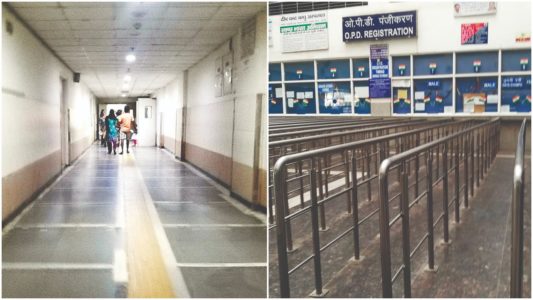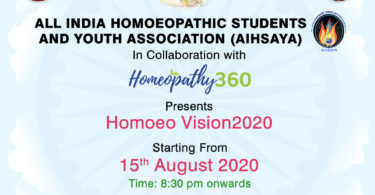 Delhi government hospitals see a huge rush in their Out-Patient Departments (OPD), where thousands of patients line-up to be treated. Deen Dayal Upadhyay Hospital receive over 5,000 patients on an average in its OPD every day and this leads to overcrowding. AIIMS, which is a central government tertiary care hospital, receive anywhere between 9,500-10,000 patients everyday, who throng the gates of the hospital from as early as 4 am. The systems at these overcrowded hospitals are breaking due to constant rush of people; doctors are either too exhausted or patients have to wait for months to get the simplest of tests done for free.
Delhi government hospitals see a huge rush in their Out-Patient Departments (OPD), where thousands of patients line-up to be treated. Deen Dayal Upadhyay Hospital receive over 5,000 patients on an average in its OPD every day and this leads to overcrowding. AIIMS, which is a central government tertiary care hospital, receive anywhere between 9,500-10,000 patients everyday, who throng the gates of the hospital from as early as 4 am. The systems at these overcrowded hospitals are breaking due to constant rush of people; doctors are either too exhausted or patients have to wait for months to get the simplest of tests done for free.
While there are overcrowded hospitals, there are also hospitals which have existed for several years but due to either lack of necessary infrastructure or awareness, stand today as the proof of bad planning and under-utilisation of available resources, as their halls remain empty. Amid these, exist hospitals which were made with big visions, but could never walk the walk due to lack of resources and equipment.
DNA looks at the status of some of these hospitals which were supposed to share the load of the overcrowded hospitals, but instead have become dependent on them, thus leading to more half-treated or ill-treated patients at the existing hospitals’ doorsteps. Deep Chand Bandhu Hospital, a 200-bed hospital in North-West Delhi, has around 2,500 patients coming to its OPD every day. The hospital, with limited staff and facilities, has been managing the inflow of patients since it was inaugurated five years ago in 2013. Although it shows that ‘surgery’ is available on their website; only two of the four Operation Theatres (OTs) are functional at the hospital.
“Since last two months we have started most of the secondary-level Operations at the hospital. Two of our operation theatres are functional and we have recently received OT rights for the other two. The government is now pursuing for the staff. We should have everything else in place soon. There is no waiting time at our hospital and the labor room is functional too,” said Dr Suman Kumari, Medical Superintendent, Deep Chand Bandhu Hospital.
There is no answer, however, why it has taken so long to make the two OTs work, which were still not functional until six months ago. Most of the hospital, on any given day, is deserted and still awaits the high-end equipment. The fire clearance, for the main building of the hospital, came late in 2014 after which started a long series of communication between the hospital staff and the government. The hospital has been running its Intensive Care Unit (ICU) since the arrival of ventilators in December 2016 with the available staff, but the OT structures are still vacant, waiting for the surgeries to start.
The hospital has been referring most of its patients to Lok Nayak Hospital and Ram Manohar Lohia Hospital for major surgeries, which leave patients traumatised as they come here from far off places. The number of patients has been on a consistent rise at the Chaudhary Brahm Prakash Ayurved Charak Sansthan, a Delhi government ayurvedic hospital, since last year, clearly indicating an increase in awareness towards the benefits of alternate medicines. The hospital had been receiving 1,000 patients per day on an average until 2016 which reached 2,000 last year and has been increasing since, making it the first Ayurvedic hospital in India with such high number of patients in a day.
But despite the increasing number, there is a huge staff crunch at the hospital along with inadequate facilities, which is disappointing to the patients coming in from far off places.
“We are always short-staffed as most of the sanctioned posts are still vacant. Not just this, the advertisements for the sanctioned posts have not been sent out at all. People have been quitting and the load on the existing staff is increasing by the day. Also, there has been no research work going on,” said a senior department head on the condition of anonymity.
In the Comptroller and Auditor General of India (CAG) report released in March 2018, which shared the auditing findings of the Directorate of Ayurveda, Yoga and Naturopathy, Unani, Siddha, and Homeopathy, the CAG revealed the shortage of staff in the three AYUSH hospitals and 24 dispensaries apart from the inadequate facilities.
“Equipment and infrastructure facilities in AYUSH hospitals and dispensaries such as drug storage, emergency services, medical record department, essential diagnostic equipment, operation theatres, and ambulances were inadequate. Of sanctioned posts of 163 doctors and 155 pharmacists in its dispensaries, only 135 and 91 posts are filled respectively. Only 24 homeopathic dispensaries of the 103 has full complement staff. Whereas, all three hospitals – Tibbia College, BR Sur Homeopathic Medical College Hospital and Research Centre, and Chaudhary BrahmPrakash Ayurvedic Charak Sansthan (CBPACS) – have between 37 and 52 per cent staff only,” stated the report.
Only 40 per cent of the essential medicine was provided to the Ayurvedic and Unani dispensaries and 43 per cent was available at Homeopathic dispensaries. Those available were procured with reduced shelf-life ranging between 25 and 58 per cent.
The CAG report also pointed out that the drug controller conducted only 8,267 and 149 inspections as compared to 31,424 and 180 inspections in Homeopathic and Ayurvedic & Unani medicine manufacturing units.
The hospital, with a 210-bed capacity, has a 95 per cent occupancy at all times. Patients from Uttar Pradesh, Rajasthan, and Bihar come here for treatment under 22 OPDs ranging from medicine, surgery, and gynae. The hospital also provides basti (oil anema), blood letting, fermentation and panchkarma therapies. But despite all this, the staff crunch remains a major issue at the hospital.
Super speciality hospitals without facilities Rajiv Gandhi Super Speciality Hospital
Nine years after the inauguration, Rajiv Gandhi Super Speciality Hospital, run by the Delhi government, barely has the required ‘specialised’ staff and facilities to cater to the treatment goals they were expected to achieve. The hospital is only partially able to perform laboratory tests for Cardiology, Neurology, Nephrology, and Gastroenterology, in which it specialises.
A large part of the hospital building is deserted. Thousands of people wait outside AIIMS and Safdarjung hospital for treatment while hospitals like Janakpuri and Rajiv Gandhi show a result of bad planning and a blurred vision. A good amount of money has been spent in ‘decorating’ the hospital than on providing healthcare.
“We conducted walk-in interviews in August and the result of it is expected some time soon. The Cardio-Thoracic department has been closed for almost two years now due to lack of staff. All efforts are being made to make it functional so that there is a government-run CTVS in East Delhi. The tender to procure a heart-lung machine has been floated as well, and GB Pant Hospital has also promised to loan us one machine whenever we get the desired staff,” said Dr BL Sherwal, Medical Director, Rajiv Gandhi Super Speciality Hospital.
“We had also put out advertisements for Rheumatology department faculty, but did not receive any response to that,” he said further.
Further to Sherwal’s statement, internal sources confirm that there used to be a Cardio-Thoracic Department (CTVS) on ground floor with three doctors, but due to unavailability of staff, the doctors left to join private hospitals. Rheumotology department closed for the same reason.
Heart Transplant machines are lying on the second floor, but there is no one to use the entire unit and the machines are still lying unused.
The Janak Puri Super Speciality Hospital started its first CATH (catheterisation laboratory for cardio problems) Lab late in 2017, nine years later, and even now, it is only equipped to perform small procedures like stenting. In the first month, the lab had only performed 33 surgeries, of which only 25 were angio/stent-related. The hospital currently receives 1,500 patients in its OPD every day, and only 40-45 patients in its IPD, but is not capable of handling any major surgeries due to lack of OTs.
“We currently do not have a Nephro/Neuro or Gastro surgeon, but we have floated a tender for OTs and in the coming six to eight months, we will have seven OTs. We are also looking to start the dialysis treatment in the near future,” says Dr Ashok Kumar, Medical Superintendent, Janak Puri Super Speciality Hospital.
The 650-bed Rajiv Gandhi Super Speciality Hospital was inaugurated along with the 250-bed Janakpuri Super Speciality on a budget of Rs 150 crore, back in 2008. Since then, the hospitals have not been able to walk the walk. Currently, the hospital has ECG, ECHO, and TMT facilities available for heart patients, but the major surgeries are yet to start. The unavailability of these treatments raises questions on the specialised healthcare facility.
The Delhi High Court noted that a “great public expense” went into building both the hospitals and in procuring medical infrastructure in the form of equipment and highly specialised diagnostic machines. The shortage of staff has, however, “translated into both severe lack of access to cheap or free medical aid to the general public and scarcity of such public resources, though physical infrastructure has been created”.
DESERTED OTS
Deep Chand Bandhu Hospital, a 200-bed hospital in North-West Delhi, has around 2,500 patients coming to its OPD every day. Although it shows that ‘surgery’ is available on their website; only two of the four Operation Theatres (OTs) are functional
OUTNUMBERED
. 10,000 – patients are, on an average, received by AIIMS in its OPD everyday. Major surgeries or lab tests are booked for the next six months in all major departments
. 8-9,000 – patients are attended to by Safdarjung and RML hospital in their OPDs, apart from hundreds of admissions and casualties every day
. 3,000 – patients are received by Sucheta Kriplani Hospital in its OPD and
. 2,000 – to 2,500 are seen by Chaudhary Brahma Prakash Charak Sansthan, Deep Chand Bandhu Hospital, Rajiv Gandhi and Janakpuri Super Speciality Hospitals on a daily basis. A lot of times, they either turn the patients away or refer them to major hospitals
. 1,000 – patients get attended to at Kalawati Hospitals in its OPD. Both hospitals are associated with Lady Hardinge Medical College
Source: https://www.dnaindia.com/delhi/report-all-is-not-well-for-delhi-s-hospitals-2672025





